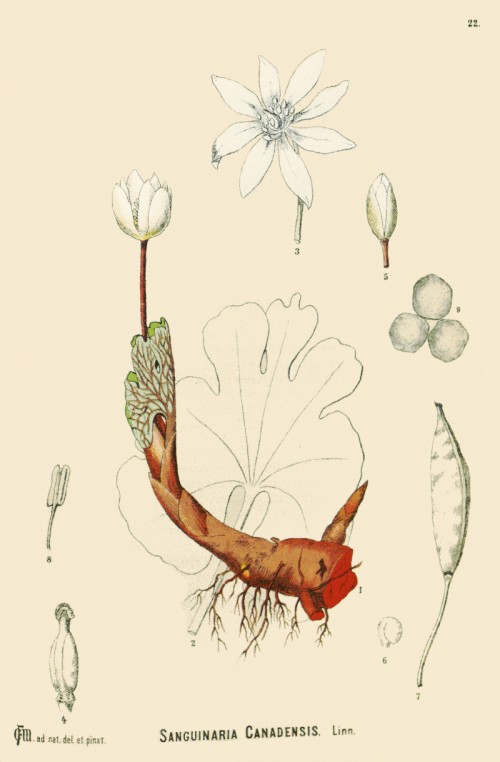Dies ist eine alte Version des Dokuments!
Sanguinaria canadensis L. - Papaceraceae: - bloodroot, red pucoon, Amerikanische Blutwurz
Perennial herb, up to 40cm tall, native in Northern America, also cultivated; rhizomes branching; leaves blue-green, palmately 5-7-lobed, orbiculate-reniform to cordate-sagittate in shape; flowers solitary, white or pinkish, flowering earliest spring; capsule fusiform, 3.5-6cm; seeds black to red-orange.
„Although bloodroot is an ingredient of some compound cough remedies, it contains the poisonous alkaloid sanguinarine, and the U.S. Food and Drug Administration has characterized Sanguinaria canadensis as an unsafe herb (J. A. Duke 1985). Native Americans used it medicinally to treat ulcers and sores, croup, cramps, burns, tapeworms, fevers, diarrhea, and irregular periods, in cough syrups, as a spring emetic and blood purifier, to stop vomiting, and as a love charm, as well as in cermonial face paint (D. E. Moerman 1986).“
http://www.efloras.org/florataxon.aspx?flora_id=1&taxon_id=220011939
„In isolated, isometrically contracting left guinea pig atria, sanguinarine, a benzophenanthridine alkaloid from the papaveracea Sanguinaria canadensis, produced a concentration-dependent positive inotropic effect. Between 2.3 × 10−6 M and 6.5 × 10−5 M, sanguinarine increased contractility by 108% which was comparable to the maximal inotropic effect of ouabain. Within the same concentration range, sanguinarine caused inhibition of Na+,K+-ATPase isolated from guinea pig myocardium. 100% inhibition of Na+,K+-ATPase activity occurred at 1 × 10−4 M sanguinarine. The I50 for enzyme inhibition and the ED50 for the inotropic action of sanguinarine were the same (6–6.5 × 10−6 M) indicating that both effects may be causally related.“
[Sanguinarine: a positive inotropic alkaloid which inhibits cardiac Na+, K+-ATPase., Seifen, E., Adams, R.J., Riemer, R.K., European journal of pharmacology, 60(4), 1979, 373-377]
„The rhizome extracts, as well as a methanol extract of S. canadensis suspension-cell cultures inhibited the growth of H. pylori in vitro, with a MIC50 range of 12.5–50.0 µg/ml. Three isoquinoline alkaloids were identified in the active fraction. Sanguinarine and chelerythrine, two benzophenanthridine alkaloids, inhibited the growth of the bacterium, with an MIC50 of 50.0 and 100.0 µg/ml, respectively.“
[In vitro susceptibility of Helicobacter pylori to isoquinoline alkaloids from Sanguinaria canadensis and Hydrastis canadensis., Mahady, G.B., Pendland, S.L., Stoia, A., Chadwick, L.R., Phytotherapy Research, 17(3), 20003, 217-221]
Sanguinarine has recently been shown to exhibit potent anti-MRSA activity in vitro by disrupting the cytoplasmic membrane of MRSA. „The activity of sanguinarine against MRSA strains ranged from 3.12 to 6.25 µg/ml, while the minimum inhibitory concentrations of the two reference strains are 3.12 µg/ml and 1.56 µg/ml. The treatment of the cells with sanguinarine induced the release of membrane-bound cell wall autolytic enzymes, which eventually resulted in lysis of the cell.“
[The mechanism of action of sanguinarine against methicillin-resistant Staphylococcus aureus., Obiang-Obounou, B.W., Kang, O.H., Choi, J.G., Keum, J.H., Kim, S.B., Mun, S.H., Kwon, D.Y. The Journal of toxicological sciences, 36(3), 2011, 277-283]

Millspaugh,C.F., American medicinal plants, vol.1, t.22 (1892)
http://plantgenera.org/species.php?id_species=904722
